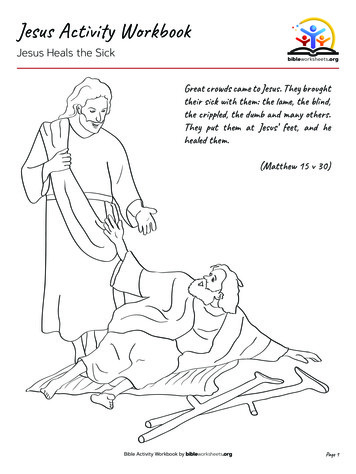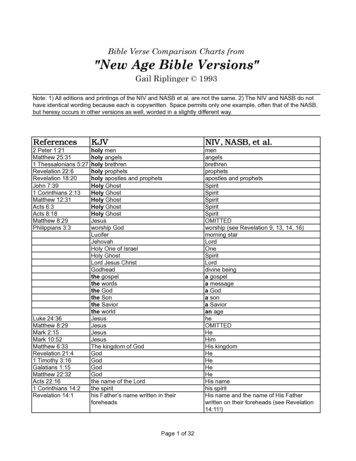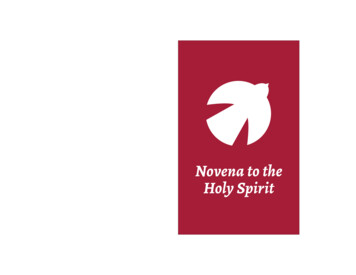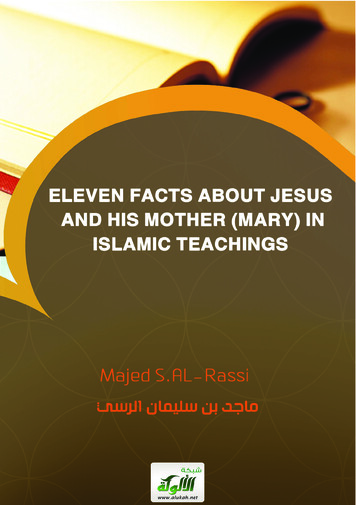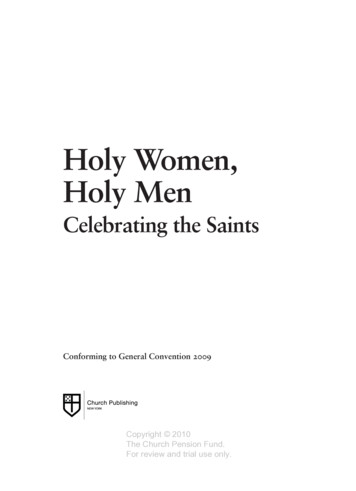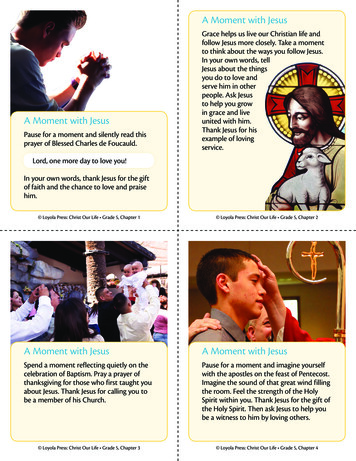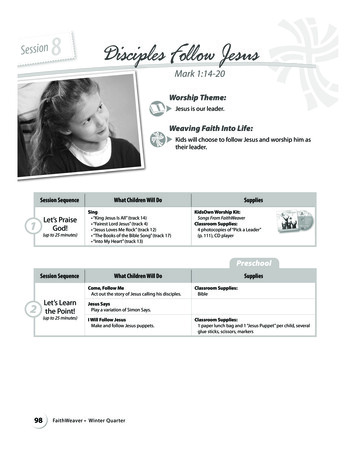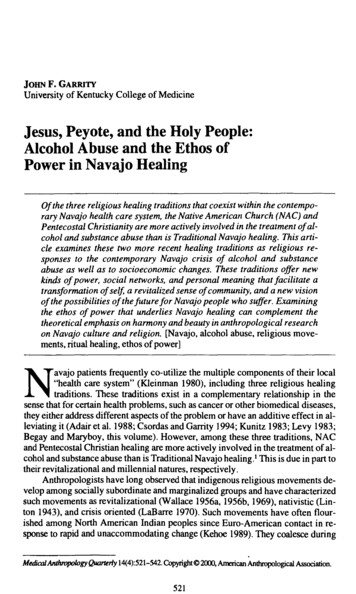
Transcription
JOHN F. GARRITYUniversity of Kentucky College of MedicineJesus, Peyote, and the Holy People:Alcohol Abuse and the Ethos ofPower in Navajo HealingOf the three religious healing traditions that coexist within the contemporary Navajo health care system, the Native American Church (NAC) andPentecostal Christianity are more actively involved in the treatment of alcohol and substance abuse than is Traditional Navajo healing. This article examines these two more recent healing traditions as religious responses to the contemporary Navajo crisis of alcohol and substanceabuse as well as to socioeconomic changes. These traditions offer newkinds of power, social networks, and personal meaning that facilitate atransformation of self, a revitalized sense of community, and a new visionof the possibilities of the future for Navajo people who suffer. Examiningthe ethos of power that underlies Navajo healing can complement thetheoretical emphasis on harmony and beauty in anthropological researchon Navajo culture and religion. [Navajo, alcohol abuse, religious movements, ritual healing, ethos of power]Navajo patients frequently co-utilize the multiple components of their local"health care system" (Kleinman 1980), including three religious healingtraditions. These traditions exist in a complementary relationship in thesense that for certain health problems, such as cancer or other biomedical diseases,they either address different aspects of the problem or have an additive effect in alleviating it (Adair et al. 1988; Csordas and Garrity 1994; Kunitz 1983; Levy 1983;Begay and Mary boy, this volume). However, among these three traditions, NACand Pentecostal Christian healing are more actively involved in the treatment of alcohol and substance abuse than is Traditional Navajo healing.1 This is due in part totheir revitalizational and millennial natures, respectively.Anthropologists have long observed that indigenous religious movements develop among socially subordinate and marginalized groups and have characterizedsuch movements as revitalizational (Wallace 1956a, 1956b, 1969), nativistic (Linton 1943), and crisis oriented (LaBarre 1970). Such movements have often flourished among North American Indian peoples since Euro-American contact in response to rapid and unaccommodating change (Kehoe 1989). They coalesce duringMedical Anthropology Quarterly 14{4):521-542. Copyright 2000, American Anthropological Association.521
522MEDICAL ANTHROPOLOGY QUARTERLYcrises of cultural disorganization and distortion marked by increased individualdistress, alcohol and substance abuse, crime, and violence. Wallace (1956b) observed that these crises generate a need for novel interpretations of the meaning oflife and how it should be lived. These crises are both personal and social and require a reworking of meaning at both the individual and group levels through theformulation of a new sacred code (Bourguignon 1976; Kehoe 1989). The successof the new code requires synthesizing elements of traditional meaning with thoseof the changing present to create a new vision of the possibilities of the future(Wallace 1956b).My intent is not to suggest a direct cause and effect. Certain conditions, however, broadly define the taking up of new religious movements. Important amongthese is social suffering, which in turn predisposes people to seek healing (Kleinman et al. 1997). When the current healing system or systems of any given cultureare unable to adequately address certain forms of suffering and, further, are unableto initiate sufficient modifications to address new forms of suffering, it is morelikely that new forms of healing will be taken up.Three major crises have occurred among the Navajo within historical times.The first was their military defeat by the United States and subsequent forcedmarch and internment at Bosque Redondo in the late 1860s (Bailey and Bailey1986; Bailey 1964). The second was the forced livestock reduction program carried out by the federal government in the 1930s (Aberle 1966, 1982; Bailey andBailey 1986; Henderson 1989). Aberle (1982) suggests these crises were a shockto the Navajo in that the power of their Traditional religion proved ineffectiveagainst them. The second crisis also initiated the disruption of traditional patternsof wealth and kinship and played a significant role in the Navajo inception of theNAC (Aberle 1965,1966).I suggest that the third crisis among the Navajo people is the present-day crisis of alcohol and substance abuse.2 Alcohol abuse, in particular, is a major factorin the higher rates of morbidity and mortality found among many North AmericanIndian peoples (Lamarine 1988; Mail and Johnson 1993; Manson et al. 1992; May1982, 1989). American Indian youth are especially at risk (Blum et al. 1992;Fleming et al. 1996). The Navajo alcohol-related death rate, once 20 times that ofthe total U.S. rate (Haraldson 1988), is currently more than seven times that of thetotal U.S. rate (U.S. Indian Health Service [U.S.I.H.S.] 1997). The Navajo Nationconsiders alcohol abuse to be the most serious problem now facing the Navajo people (Navajo Nation Division of Health 1991). A Traditional diagnostician spoke ofalcohol as a dangerous enemy that threatens yet baffles the Navajo people:It is like some kind of spirit that exists with danger and something on the scale ofwar. It travels around everywhere. People say someone died from this and that andyet it is much bigger. We are at war with this thing yet we don't know, we justdon't know where and how it travels to destroy people. on the scale of disease.We need to have many medicine men get together and see what is happening to us.We need to discuss what is happening to people. We may never know the realcause but if we fight it together we will curb it.Navajo use and abuse of substances such as marijuana, cocaine, and amphetaminesalso constitute a serious problem, particularly among the youth, and "polysubstance"abuse remains a severe problem across ages. The latter involves adolescents who
JESUS, PEYOTE, AND THE HOLY PEOPLE523"sniff glue, paint thinner, and gasoline (inhalant abuse), as well as alcohol-dependent persons who consume commercial products such as hair spray and mouthwash during desperate attempts to stave off withdrawal. Young children oftenbegin abusing inhalants at a very early age before moving on to alcohol and moremainstream drugs.Alcohol and substance abuse embodies both an intense personal crisis for individuals who suffer and a crisis that threatens the Navajo people. It would be safeto say that almost all Navajo people have been affected by this crisis in some way,through their own personal suffering with alcohol and drugs or that of a familymember, or as innocent victims of alcohol-related accidents or violence. At boththe individual and group levels this crisis demands a reformulation of how and whylife can be meaningful and worth living. I suggest that the growing popularity ofthe NAC and Pentecostalism in contemporary Navajo society is due in part to theirdistinctive ability to address the crisis of alcohol and substance abuse. The takingup of these two new sacred codes assists in the reformulation of meaning for thosewho suffer.Navajo Social and Religious ChangeThe growth of the NAC and Pentecostal Christianity among the Navajo is intertwined with the vast changes taking place in Navajo society today as it continuesits transition from pastoralism toward a predominantly wage-labor economy(Kunitz and Levy 1994; Levy 1998; Weiss 1984). On the one hand, these changesinclude greater educational and economic opportunities for many young Navajos,as well as the emergence of women in more influential public roles (Lamphere1989). On the other hand, these changes continue to profoundly disrupt traditionalkinship networks and their patterns of wealth (Aberle 1989; Henderson 1989; Levyet al. 1989) and substantially diminish the opportunity for participation in Traditional religious life for many Navajos. Contemporary Navajo society is complexand diversified. Faced with a growing population, a limited resource base, and aproportionately poor economic status, it is becoming more competitive, as familiesand individuals must vie for scarce land, water, jobs, education, and medical services. With the emergence of a new order of educated, white-collar professionalswho reap comparatively higher earnings in the government and services sector, itis also to a certain extent becoming more stratified.The transition toward a wage-labor economy, together with the attendantmodernization of the Navajo infrastructure has dramatically increased the mobilityof the Navajo people and their access to goods and services in neighboring bordertowns, including access to alcohol (Bailey and Bailey 1986; Kunitz and Levy1994). Prior to these developments, alcohol was more difficult to procure, anddrinking tended to be carried out in kin group settings in rural areas of the reservation (Kunitz and Levy 1994). Contemporary drinking patterns differ, in part, in thatthey involve an abundant supply of alcohol accessible to almost all Navajo peopleand include the added, potentially dangerous element of motor vehicle travel toand from border towns (Kunitz and Levy 1994).Moreover, Navajo people view alcohol abuse itself as. being profoundly disruptive of traditional kinship networks and patterns of wealth. This was forcefully
524MEDICAL ANTHROPOLOGY QUARTERLYconveyed in the narrative of one Pentecostal minister, who recalled his life growing up and why he chose Christianity:1 don't remember being taught about kinship and relatives, they never introducedus to . . . clan relations. Our parents were drinking all the time. They never reallytaught us anything. There was never enough, we used the handouts from different placesWe drank up our livestock. So my aunts and other relativesstayed away, they didn't come to help. My dad is a medicine man. his fatherwas a medicine man so he became a medicine man . . . and he wanted me to takehis place . . . and he was gonna teach us in the traditional way. Instead, the drinking took over.The diminished opportunity for participation in Traditional healing has beenfurther attenuated as the result of changes taking place within Traditional Navajoreligion itself. Although Traditional ceremonies, or chants (hatMl), are still conducted frequently across the reservation, there has been both a steady aging andconsequent decline in the number of practicing chanters (hataaiii) and a lack of recruitment of younger men to train (Aberle 1982; Henderson 1982).3 NumerousTraditional chanters we worked with lamented this trend as yet another crisis facedby their people. A related concern has to do with language, a critical element inNavajo culture and healing (Gill 1977, 1980; Reichard 1944; Witherspoon 1977).While the Navajo language is not in immediate danger of becoming moribund,there continues to be a proportionate decline in fluent speakers, especially amongthe younger generation (Aberle 1982).Many of the older Traditional practitioners commented that the Navajos arelosing their cultural ways, and various scholars have implied this as well (Aberle1982; Bergman 1973; Farrella 1984). It is not my intention, however, to suggestthis. Our research suggests that it is more appropriate to consider the two more recent healing traditions in the context of cultural change than of cultural loss. Traditional Navajo religion itself is predicated on change and adaptation (Adair et al.1988; Haile 1938; Levy 1998; Wyman 1983). Historically, ceremonial masks andsandpaintings were borrowed from the Pueblos, while hand trembling (ndishniih),a form of diagnosis, and the Chiricahua Windway chant (ChishiBinilch'iji) wereadopted from the Apache (Adair et al. 1988; Haile 1938; Levy 1998).4 TraditionalNavajo religion continues to change and adapt today (Levy 1998). Shorter overnight versions of ceremonies are appearing that fulfill the purposes originallyserved by longer sings. Kunitz and Levy (1994) and Levy (1998) note the growingpresence of "New Age" concepts among younger Navajos reinterpreting Traditional Navajo religion and healing practices. Perhaps the most prominent image ofchange is the Traditional chanter I met who takes calls on his cellular phone whiletraveling in his pickup truck. In spite of these changes, Traditional healing has become inaccessible for many Navajos, who today lack the traditional resources andsocial networks necessary to have a major ceremony, as well as the linguistic fluency and familiarity with traditional culture necessary to embrace its ritual symbolism.The Traditional Chanters we worked with were strongly opposed to alcohol.Yet the overall consensus was that there is no Traditional ceremony to treat alcoholand substance abuse. One Beauty way (Hoozhonee) chanter explained:
JESUS, PEYOTE, AND THE HOLY PEOPLE525A person that's become addicted to wine, alcoholic drugs, there is no such ceremony for this. The ceremonies were created I don't know how many million yearsago. Wine or alcoholic drugs were created just recently; therefore there are noceremonies for it. Marijuana is another one that is without a ceremony so there'sreally nothing that you can do . . . because it's a recent invention.This is a plausible explanation save that Traditional healing has been extended toother more recent afflictions such as cancer (Csordas 1989). Kunitz and Levy(1994), however, report indications that alcohol was positively valued in Navajosociety from the late 1800s through the 1960s and was associated with prestige,wealth, and status. It was especially valued for the sense of power it gave, and someTraditional chanters drank to facilitate manipulation of supernatural power (Kunitzand Levy 1994). This may explain, in part, why Traditional healing never developed a treatment to address alcohol problems.While the patients we worked with did not directly state that they drank alcohol to gain power, they frequently spoke of alcohol as a power that eventually controlled them. This realization, the consummation of their alcohol-related sufferingbecoming unbearable, drove them to seek NAC and Pentecostal Christian healing.Moreover, within all three healing traditions, patients frequently expressed a rangeof other distress besides that caused by alcohol abuse (such as depression or anxiety) in terms of being "out of control" or "controlled by" something, such as aspirit. This further underscores the Navajo experiential salience of power and theproper control of power.Many Traditional chanters blamed the whites for creating alcohol and bringing it to the Navajo. This was often articulated in relation to themes of pollutionand disruption of the natural balance as the result of modern technology thrustupon the Navajos by the dominant society. This highlights the tension underlyingthe relationship between Navajo and Anglo society and underscores the powerlessness often perceived by Navajos within that relationship, as well as with respect toalcohol itself. A Chiricahua Windway (Chishi Binilch'iji) chanter lamented:Anglos know more about this, or they should know more about alcohol and alcohol problems because they are the makers of these chemicals. We don't know ashealers. I don't know exactly why people drink. I think the Anglos and the government are responsible . . . I don't understand, why can't the ones who are responsible for this or the authorities stop or prohibit alcohol? It does not makesense.Traditional chanters also felt that alcohol and substance abuse, particularlyamong the youth, was the result of the Navajos losing their traditional ways. As aBlessingway (Hozhggji) chanter observed:Some patients now do not know about the ceremonies. The more exposure one hasto the ceremonies, then the more familiarity or awareness one starts to have aboutwhat is really going on. Language is a big barrier. The youth, there are so manywho do not speak Navajo. They speak only English, and the mothers just pray forthem. This is a difficult task for u s . . . . It is so obvious why the children do not listen and know anything anymore. It is because of the Anglo way of life; the television, the things they have in their ears. So they don't hear you when you try to talkto them. If we turn away from all this, then we will straighten up and recapture ourlanguage and culture.
526MEDICAL ANTHROPOLOGY QUARTERLYFinally, some chanters felt that one who suffers from alcohol abuse may be the victim of witchcraft, and they made indirect statements such as "There is lots of jealousy among the Navajo, that is probably one of the main causes of all theseproblems," or "I'm sure someone was meaning to hurt the person, and the patientnever did anything about it to prevent this from happening."5Two minor ceremonies, the "Tobacco Smoking Way" and 'Turning of theBasket," were often mentioned as possibly beneficial, not specifically for alcoholand substance abuse problems but, rather, for "people with mind problems" and"problems of the emotions." Such problems manifest themselves in a range of inappropriate behaviors, such as "a person who wanders from home or strays away,""violent behavior and trouble with the law," and "overindulging with having sexwith women." The tobacco ceremony is used to "help cleanse and straighten outthe mind." The basket ceremony is similarly used for "correcting one's mind andthoughts" and for "restoring and maintaining harmony in one's life." The chantstalk about how "the patient's mind is ceasing its wandering and returning backhome."6Overall, in the words of one among their number, the consensus of chanterswas "That's all you have done [can do] for these alcoholics and [those who abuse]drugs. It's up to them, it's really good if they fully give it up. If they still holdon to it, then it's not good and it's not going to work. If they fully give up drinking.then the person will live a good life again. If the person keeps returning to drinking,then it's not effective." These themes of inefficacy, Euro-American hegemony,culture loss, witchcraft, and the contingency of patients' personal willpower underscore the pervading sense of the power of alcohol and other substances, and thelack of power in Traditional healing to address their abuse. Another ChiricahuaWindway chanter captured this sense of bdhddzid (dangerous) power in the following way:If one takes a little sip of the alcohol, the person will just want to do that and it'llget serious and now they are addicted to drugs. There will be something bad sitting on your shoulder and telling you in your ears to drink some more. If you drinksome more then you can take pride in yourself, and you will know more, and drinkmore and more, until you lose your mind and not know what you are doing. That'swhen he'll desert you. All you're going to see is his tracks going in that direction.Arlene, one of the Traditional patients we worked with, had the basket-turning and tobacco ceremonies performed for her as she sought to reverse her heavyuse and abuse of marijuana, cocaine, and amphetamines. An urbane, yet disenchanted woman of 18, she identified herself as being "addicted to drugs" and suffering from "depression" (see Storck et al., this issue), which she described as feeling like "something evil is trying to control my mind." She also hoped theexperience would help her "get in touch with where I come from and who my people are." The ceremonies, comparatively short yet rich in symbolism, were provided for her free of charge by her grandfather, which allowed her to bypass themarshaling of resources that normally hinders people with alcohol and substanceabuse problems.Arlene's lack of knowledge of traditional culture and healing, however, mademuch of the ritual enigmatic to her, and she was unable to discern any personal significance in the symbols, reporting, "I haven't thought about that much, I'm noi
JESUS, PEYOTE, AND THE HOLY PEOPLE527sure what that meant." Moreover, her lack of fluency in Navajo posed a critical obstacle for her engagement in the therapeutic repertoire of Traditional healing. Sheacknowledged, "I had a hard time understanding what they were saying . . . I triedto understand parts of itBut it's so hard because I can barely speak my ownlanguage." Her substance abuse and attendant suffering continued unabated, andmonths later she still related, "I'm having a hard time trying to understand that, andI'm trying to figure out how I can change that." Her grandfather observed that "sheshould have had more benefits from the ceremony," yet acknowledged that "sheprobably couldn't grasp and understand the ceremony fully and reap all of its benefits" because of "the language barrier." This is not to say that Traditional healing istotally inaccessible to all young or contemporary Navajos. This brief vignette,however, illuminates the predicament faced by Navajos who seek transformationthrough Traditional healing, yet lack traditional cultural knowledge and Navajofluency.The Appeal of NAC and Pentecostal Christian HealingPart of the apparent therapeutic efficacy of NAC and Pentecostal Christianhealing lies in their ability to synthesize cultural, linguistic, symbolic, ritual, andsocial elements of meaning from the traditional orientation with those of the contemporary Navajo sociocultural milieu. Let us now examine some of the culturalsimilarities inherent in these healing practices that make them accessible and appealing to contemporary Navajo people.The NAC is particularly adept at innovation, a quality grounded in its historyas an intertribal and syncretic movement. The NAC was introduced to Navajolandin the 1930s by Plains Indians. As practiced by the Navajo today, however, its rituals appear to contain fewer Christian elements than are found among the Plains andeastern tribes (LaBarre 1959; Spindler 1971) and, to a certain extent, fewer thanwere first observed by Aberle (1966) in the early 1950s. NAC healers are known asroad men, because they guide one's journey through life on the "peyote road."Some road men began as Traditional practitioners, and we have found that, on thewhole, Navajo road men increasingly are creatively integrating more Traditionaldiagnostic techniques (see Milne and Howard, this issue), treatments, and explanatory models (Kleinman 1980) into their therapeutic repertoire. These include diagnostic practices such as "listening" and "stargazing." Road men are also beginningto conduct peyote meetings that expressly correspond to Traditional ceremoniessuch as Blessingway (Hozhppji) and Lightningway or Shooting way (Na'at'oyee'ji),as well as Evilway (Hochxo'iji) and Windway (Nflch'iji). One road man even referred to plans to learn and integrate Traditional sandpaintings into his NAC prayermeetings. Use of the sweat lodge, frequently in a Plains Indian style, is another example of NAC innovation. Traditionally, Navajo sweat baths comprised a rite ofpurification and preparation for longer religious healing ceremonies. Today, particularly in NAC circles, the sweat bath is beginning to take on the significance of ahealing ceremony in its own right. It is frequently employed as therapy for alcoholabuse, particularly for individuals who have grown up experiencing a sense of estrangement from their Navajo identity, language, and culture.7Other researchers have noted that increased participation in peyote meetingsis correlated with a decrease in Traditional Navajo ceremonies in some regions of
528MEDICAL ANTHROPOLOGY QUARTERLYthe reservation (Aberle 1982; Kunitz 1970). This is not necessarily a form of zerosum competition, however, and can be understood in terms of NAC healing fillinga therapeutic niche created by the decline in numbers among Traditional cermonialists. That is, road men are able to offer services that are meaningful in traditionalterms but that are becoming less available from Traditional practitioners. In thissense, the NAC of Navajoland is engaged in the preservation of traditional cultureand religion—albeit in a transformed state to which some traditionalists strenuously object—rather than competition and eradication.Navajo Pentecostal services are conducted at least partially in the Navajo language. Scripture is consulted as a metaphysical and existential blueprint in thesame way as the Traditional origin stories. The Biblical imagery and metaphors ofshepherding flocks, wandering in the desert, and healing the afflicted are particularly germane to the Navajo experience, and there is a strong emphasis on divinepower. Camp meetings and revivals resemble the gatherings that occur duringlarge Traditional sings such as the Enemyway.Christianity began its contemporary florescence as the result of the vigorousmissionary activities of various evangelical sects during the 1950s, and particularly because of their innovative approach to training and ordaining Navajo ministers (Bailey and Bailey 1986). The most recent comprehensive survey indicatedthat by the late 1970s there were 343 independent evangelical churches, 200 ofwhich had Navajo pastors (Aberle 1982; Dolaghan and Scates 1978). The movement continues to grow, and there is currently an abundance of ordained NavajoPentecostal ministers. Although there are certainly Navajo ministers who are antagonistic to traditional culture, others we interviewed nurture a deep sense ofpride and respect for their Navajo cultural heritage and concern for the preservation of the Navajo language and traditional way of life, both of which are intrinsicto their self-identity, save for their religious orientation. They also express a profound compassion for the Navajo people and the kinds of problems and sufferingthey face, particularly the youth. In these respects, they are indistinguishable frommany of their Traditional and NAC counterparts. The lifestyle of one elderly minister I worked with was strikingly similar to those of elderly Traditional chanters.He spoke fluent Navajo, tended his animals, repaired his own vehicle and home,and prayed when he planted his corn, except that he offered his prayers to Jesus, forJesus's power had healed him from alcohol abuse.Theological differences among Pentecostal Christian churches within Navajoland are deemphasized. Ministers of different churches consult with one anotherregularly, and members of different congregations worship together frequently,particularly at camp meetings and revivals. Overall, there is shared feeling of beingChristians, or oodldni (believers), rather than members of a particular sect, such asthe Assemblies of God or the Church of God Holiness. Congregations are alsomoving toward establishing more independence from the mother churches outsideof Navajoland that sponsor them. Given these elements, it would not be surprisingto see a Navajo indigenous Christian church develop in the future, similar to theNAC of Navajoland, which maintains ties with other NAC charters in North America, yet has come to represent a distinctly Navajo version of the practice. Whenfirst introduced among the Navajo, the NAC was dismissed by many traditionalistsas a foreign religion (Aberle 1966). Today, Pentecostal Christianity cannot be dismissed as merely a foreign religion perpetuated by white missionaries. Rather,
JESUS, PEYOTE, AND THE HOLY PEOPLE529Pentecostalism can be better appreciated as a movement in the process of becoming a bona-fide Navajo religious tradition, one that has been taken up and transformed in response to the specific needs of the Navajo people within their contemporary milieu.Finally, the preeminence of one's home and family cannot be overemphasized in both NAC and Pentecostal Christian healing. Kunitz and Levy (1994:138)note that in addition to greater access to alcohol and cash, "the absence of functioning kin groups and the responsibilities and values they foster," the "empty nestphenomenon among women in nuclear families whose children have grown andleft home," and, in general, "the absence of a sense of community" are elementsthat foster problem drinking among some Navajos. The distinct ability of both theNAC and Pentecostal Christianity to provide new communities, new moralities,new forms of power, and new forms of control are significant therapeutic elementsfor individuals who suffer from alcohol and substance abuse problems.NAC Engagement of Alcohol and Substance AbuseTo a great extent NAC road men share the sentiment of Traditional chantersthat white society is to blame for manufacturing alcohol, that the decision tochange resides within the individual, and that drinking possibly can be caused bywitchcraft. In contrast to the various themes of powerlessness informing the Traditional engagement of alcohol, however, the NAC engagement of alcohol is characterized by themes of hope, transformation, new ways of living, and a sense ofpower over alcohol. In riveting testimony, road men recounted their own sufferingwith alcohol abuse prior to joining the NAC. They spoke of how they "could justnot have power over alcohol" until they were healed by the "power of the medicine." Indeed, past alcohol abuse is what compelled a substantial number of roadmen to take up the NAC in the first place. Power is highly elaborated within thishealing tradition (Slotkin 1956, 1979). Patients are cured by partaking of peyoteand absorbing its "pure healing power." During NAC prayer meetings, the roadman and other participants offer prayers to the "Merciful Creator" and the "HolyPeople," asking them to "bless this patient" and "fill him with the power that heneeds." Peyote is said to have the ability to act as "a messenger between you [i.e.,the patient] and the Creator." Summarizing the beliefs and values in Navajopeyotism, Aberle sees the practice as being appealing in part because "it offers access to supernatural power to combat misfortunes such as illness, mental distress,and poverty," and
these is social suffering, which in turn predisposes people to seek healing (Klein-man et al. 1997). When the current healing system or systems of any given culture are unable to adequately address certain forms of suffering and, further, are unable to initiate sufficient modifications to address new forms of suffering, it is more


